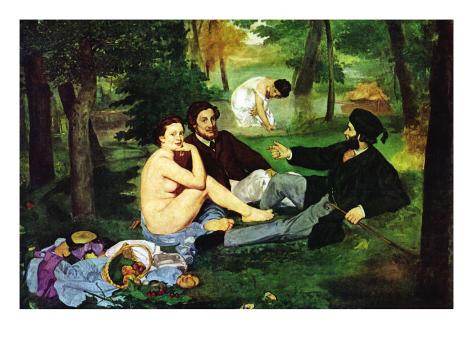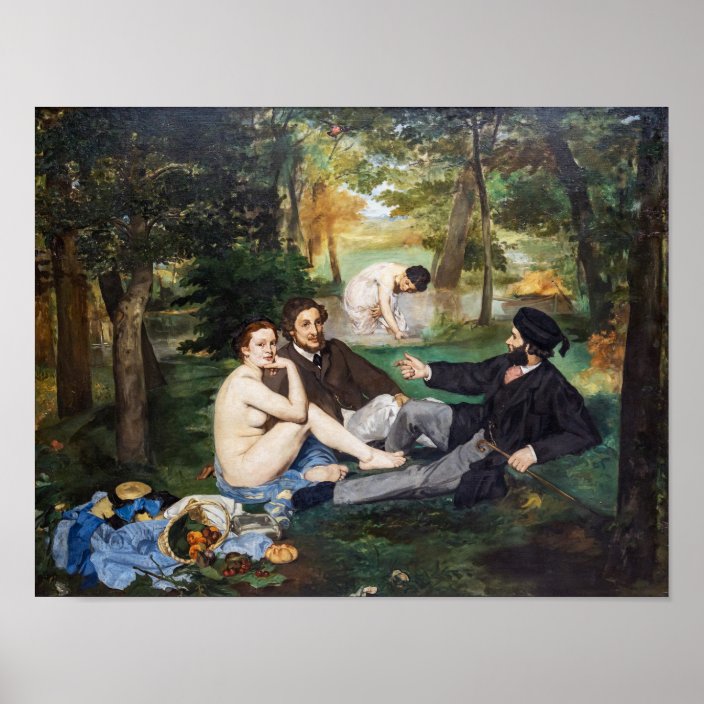
A contributor for Le Figaro Arthur Stevens, on the other hand, underlined Manet’s talent for color, yet he was not pleased with the form and the models.Įdouard Manet - Luncheon on the Grass, detail, 1863. Although sex work was an important aspect of the Parisian society, it was considered a taboo and was an undesirable motif to be represented on a painting.Īlthough Le Déjeuner sur l’herbe was rejected from the Paris Salon and provoked a number of reviews and responses after it was first displayed, not all of those analyzes were necessarily negative.Īlbert de La Fizelière, a notable art critic and a contributor for Le Petit Journal, thought that colors of the piece represented the countryside into the salon, yet the painting was according to him underdeveloped. It was and still is hard to tell whether she is inviting or challenging the viewer, or she is presenting herself proudly in flesh and equally with man.Īccording to one interpretation, the painting displays a common sex work routine typical for the Bois de Boulogne, a large park on the western outskirts of Paris. The other thing which troubled the viewers is the nude woman’s gaze. However, the main difference between the men and women is their class. There are various contradictions present on the painting – the feminine against the masculine principle, the naked versus the clothed, and the white color palette versus the dark color palette.

The female nude seems distant and somehow alienated from two male figures. The painting caused quite a shock after it was displayed for the first time and was considered indecent and vulgar, although Manet's contemporary and established writer and critic Émile Zola defended the work.Īs a matter of fact, what was so outrageous was a form of sexual tension and strange interaction, or rather the lack of it, between the three main subjects in the foreground and the bather in the background.

The other man is based on his brother-in-law, Dutch sculptor Ferdinand Leenhoff therefore, some scholars even refer to Le Dejeuner sur l’Herbe as Manet’s family portrait.Įdouard Manet - Luncheon on the Grass, detail, 1863. The figures on all of his paintings were inspired by the real models and people he knew the female nude is thought to be Victorine Meurent, Manet’s favorite and frequently portrayed model (who also posed for his iconic painting Olympia), while the male figure on the right is believed to be based on a combination of Eugène and Gustave, Manet's two brothers. Namely, the landscape represented in the painting resembles the l’île Saint-Ouen, on the outskirts of Paris near the artist’s family estate. This masterpiece was actually personal for Édouard Manet, and there are several proofs for such a claim. The overall impression is that the scene took place in a studio, since the light is low, there are no shadows, and the background lacks depth. In the background, the second woman bathes in a stream and her presence is almost ghostly and surreal due to her size (this figure is too large in comparison with the trio in the foreground). The three figures are complemented by a still life in a lower left plane of the canvas consisting of a basket of fruit, a round loaf of bread and the woman's clothes. The leading figure of the Le Déjeuner sur l'herbe painting is a nude woman who stares directly at the viewer while the two men, fashionably dressed, are caught in conversation. The Prolific Figures of Le Déjeuner sur l'herbe Painting by Manet Édouard Manet - Le Déjeuner sur l'herbe, 1869 This outstanding painting is on permanent display at the Musée d'Orsay in Paris, while an earlier, petite version can be seen at the Courtauld Gallery in London.

The rest of the text will focus on the immense influence it made on upcoming artists and the social revolt it caused for quite a long time. Manet produced this controversial work in-between 18 and was rejected by the notorious Paris Salon jury, so the artist displayed it at Salon des Refusés instead. Namely, it features a female nude on a picnic with two fully dressed men in a rural setting and a bather in the background. This astonishing composition introduced an entirely new painterly approach, since it encompassed the genres of portraiture, landscape and still life within a single painting. The perfect example of such a chiseling masterpiece is Le Déjeuner sur l'herbe or The Luncheon on the Grass by Édouard Manet. Nevertheless, some of them were radical for their time and even today they cause quite a stir. the inherited roles and modes of behavior. Modern art history is saturated with the paintings that changed the way we perceive the society, e.g.


 0 kommentar(er)
0 kommentar(er)
